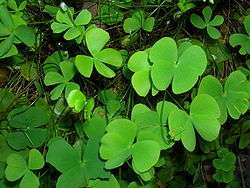Marsilea villosa
| Marsilea villosa | |
|---|---|
 | |
| Scientific classification | |
| Kingdom: | Plantae |
| Division: | Pteridophyta |
| Class: | Pteridopsida |
| Order: | Salviniales |
| Family: | Marsileaceae |
| Genus: | Marsilea |
| Species: | M. villosa |
| Binomial name | |
| Marsilea villosa Kaulf.[2] | |
Marsilea villosa, the ʻihiʻihi (Hawaiian) or villous waterclover (English), is a species of fern that is endemic to the islands of Oʻahu, Molokaʻi and Niʻihau in Hawaii. It is found exclusively in areas that experience periodic flooding and become ephemeral pools within low elevation dry forests and shrublands.[1] Standing water allows the sporocarp to open and release spores. It also enables the resulting sperm to swim toward and fertilize female ova. For new plants to become established, the waters must subside. Sporocarps only form once the soil has dried to a certain level. Like other species in its genus, the leaves of M. villosa resemble those of a four-leaf clover.[3]
Conservation
Fewer than 2,000 individual plants exist in four remaining populations. The plant was federally listed as an endangered species in 1992.[1]
References
- 1 2 3 "The Recovery Plan for the Marsilea villosa". Threatened and Endangered Animals in the Hawaiian Islands. U.S. Fish and Wildlife Service. 2010-03-24. Retrieved 2011-02-24.
- ↑ "Marsilea villosa". Integrated Taxonomic Information System. Retrieved 2011-02-24.
- ↑ "Marsilea villosa". CPC National Collection Plant Profiles. Center for Plant Conservation. 2010-03-04. Retrieved 2010-05-12.
External links
![]() Media related to Marsilea villosa at Wikimedia Commons
Media related to Marsilea villosa at Wikimedia Commons
![]() Data related to Marsilea villosa at Wikispecies
Data related to Marsilea villosa at Wikispecies
